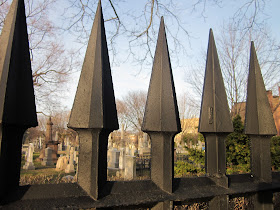Are statues and sculptures the same thing? I looked up their definitions and found this:
SCULPTURE:
SCULPTURE:
an individual piece of carving, modeling, welding, or otherwise figurative or abstract work of art in three dimensions, as in relief, intaglio, or in the round.
STATUE:
Huh? Can any of you art experts shed further light on the subject?
Anyway, when we went to San Francisco in February, the dozens of murals painted on outdoor walls all over the city really jumped out at me. In contrast, I didn't see many murals in New York City, but the statues/sculptures were fantastic. Here is a sampling of my favorites:
Debris from the collapse of the World Trade Center Twin Towers after the 9/11 terrorist attack in 2001 knocked down a 100-year-old sycamore at a nearby church. The roots were used to create this awesome piece of art next to Trinity Church:

Elizabeth Ann Seton, the first native-born American to be canonized by the Catholic Church and the patron saint of Catholic schools, stands in one of NYC's churches:
A Pieta by William Ordway Patridge found in St. Patrick's Cathedral is not as powerful as the Pieta by Michelangelo in St. Peter's in Rome, but there are many similarities that made this very appealing to me, including Mary's tenderness and the limp peacefulness of the body of Christ:
Two statues in Chinatown: Lin Ze Xu (1785-1850, Pioneer in the fight against drugs) and Confucius (551-579 BC):
Dali's sculpture The Snail and the Angel:
I love, love, LOVE this sculpture by Jim Shore entitled Keys to the Kingdom. It was outside the Lincoln Center Branch of the American Folk Art Museum. The artist is more commonly known for his resin Christmas figures that wear clothing painted with bright scenes. This angel is made from "found" objects. Her wings, for example, are made from keys:
The Peace Fountain (1985) in the yard of the St. John the Divine Episcopal Church depicts the struggle between good and evil as represented by the Archangel Michael slaying Satan, whose head is hanging grotesquely over the edge of the platform:
In some ways St. John the Divine Cathedral reminds me of Gaudi's Sagrada Familia Catedral in Barcelona, Spain--not quite finished, a mixture of styles, a very contemporary feel, and unexpected elements everywhere. I'd recommend making a detour to see it if you plan a trip to NYC.
There is something in the heavy, permanent feel of a statue that fits New York City, just as the bright, airy, impermanent murals seem to fit San Francisco.
a three-dimensional work of art, as a representational or abstract form, carved in stone or wood, molded in a plastic material, cast in bronze, or the like.
Huh? Can any of you art experts shed further light on the subject?
Anyway, when we went to San Francisco in February, the dozens of murals painted on outdoor walls all over the city really jumped out at me. In contrast, I didn't see many murals in New York City, but the statues/sculptures were fantastic. Here is a sampling of my favorites:
Debris from the collapse of the World Trade Center Twin Towers after the 9/11 terrorist attack in 2001 knocked down a 100-year-old sycamore at a nearby church. The roots were used to create this awesome piece of art next to Trinity Church:
The oh-so-austere Apostles in the niches of the Trinity Episcopal Church watch over the tree roots, as if preventing future destruction in the city:
The grave of John Watts (174901836), a NYC politician, really stands out among more modest burial sites in the Trinity Church graveyard:

The Statue of Liberty stands on a city street. Wait! Shouldn't she be out in the harbor?
Elizabeth Ann Seton, the first native-born American to be canonized by the Catholic Church and the patron saint of Catholic schools, stands in one of NYC's churches:
A Pieta by William Ordway Patridge found in St. Patrick's Cathedral is not as powerful as the Pieta by Michelangelo in St. Peter's in Rome, but there are many similarities that made this very appealing to me, including Mary's tenderness and the limp peacefulness of the body of Christ:
Two statues in Chinatown: Lin Ze Xu (1785-1850, Pioneer in the fight against drugs) and Confucius (551-579 BC):
A 3-D model of Salvador Dali's melting clock from his famous painting The Persistence of Memory:
Dali's sculpture The Snail and the Angel:
I love, love, LOVE this sculpture by Jim Shore entitled Keys to the Kingdom. It was outside the Lincoln Center Branch of the American Folk Art Museum. The artist is more commonly known for his resin Christmas figures that wear clothing painted with bright scenes. This angel is made from "found" objects. Her wings, for example, are made from keys:
I ADORED these gargoyle-like men hold up a balcony:
Michael is snuggling a baby giraffe, a symbol of peace:
Saints and apostles stand as guardians to the doors of St. John the Divine. The figures are wonderfully human and approachable. Notice the small figures above the larger ones that have colored clothing and skin:
The columns show various NYC scenes, including the Twin Towers (left):
There is something in the heavy, permanent feel of a statue that fits New York City, just as the bright, airy, impermanent murals seem to fit San Francisco.
























































